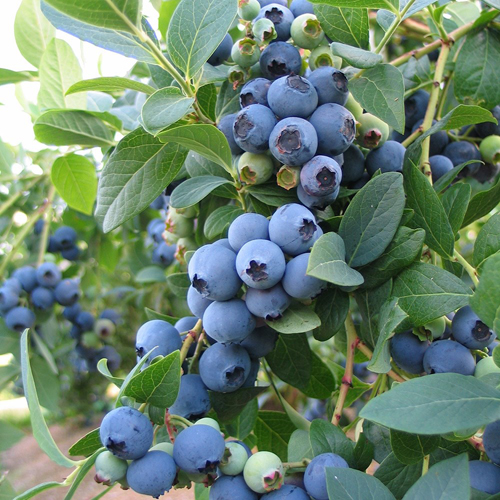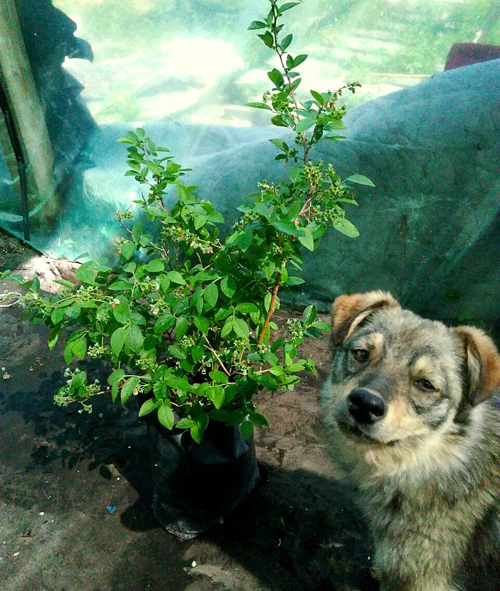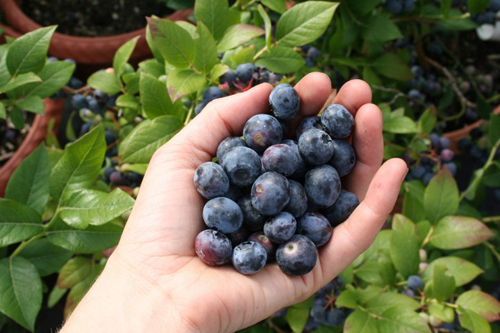Blueberry variety Bluecrop
Standard varieties exist among different berry crops. Those with whom others are compared, and those with which they are equal. And garden blueberries are no exception. The hero of our article, an American of deep retirement age, is Blyukrop, who, despite his solid years, gives odds to young ambitious new products. Many farmers around the world still plant hundreds of acres and hectares of it, preferring the proven classics and not succumbing to the advertising gimmicks of breeding companies, throwing all new, but not always worthwhile varieties on the market. And what did Blukrop deserve such love, recognition and trust - in our article below.

History of creation
Our hero was obtained in the USA as a result of crossing numbered varieties of blueberries GM-37 (Jersey x Pioneer) x CU-5 (Stanley x June) back in 1934. The work was carried out by a group of American breeders consisting of: J. Darrow, J. Clark, F. Coville, O. Freeman. The seeds obtained from the crossing were planted in the experimental plot for further observation. Then, in 1941, scientists J. Darrow and J. Clark selected the desired characteristics from more than a thousand seedlings. The new variety was named Bluecrop and went on sale only in 1952. Translated from English Blue - blue, Crop - agricultural crop, harvest.
Description
Bluecrop Bluecrop is one of the most productive, resistant, most famous, beloved and widespread varieties in the world. And so that you don't get confused, Bluerop and Bluecrop are one and the same, the only difference is in the translation of the name into Russian. The variety is mid-season, ripens in the south from the end of June, in other regions from the beginning of July. Suitable for manual and mechanized collection. Our hero is the most common industrial grade in the United States and throughout the world.
A plant with good vigor, a tall bush, stems are strong, resilient, erect, but slightly spreading. The height is mostly 1.3-2 meters. Width 1-1.7 meters. The maximum plant grows up to 2.5 meters. The bush expands significantly upward as it grows. Lateral shoots are strongly branched and thickened. Therefore, regular pruning of the stems and cutting of thin, weak branches are required, which negatively affect the future harvest and the size of the berries.

The root system of blueberries is fibrous, densely branched, and does not have suction hairs. It penetrates into the soil to a depth of 30-40 cm. For successful growth and the disclosure of all the potential inherent in it, Bluecrop requires compliance with the required level of soil acidity - pH 4.5 and below.
The leaves of the variety are dark green with a glossy sheen, dense and smooth, oval-oblong in shape with solid edges, pointed at the end. The petioles are short. In spring, young foliage can be bright green, light green in color. Therefore, it can often frighten gardeners; you can easily confuse this symptom with chlorosis, in which plants have leaves of about the same color. Bluecrop is successfully used in landscape design to decorate the site - the foliage in the fall is painted in scarlet and yellow-red colors. Plus, the shoots acquire a reddish-brown hue in the fall, which adds even more decorative effect to the entire plant.
The blooming time of this blueberry is late May or early June. Moreover, the plant successfully withstands spring frosts. The flowers are numerous, white and pale pink, on average 1 cm long, bell-shaped with 4-5 toothed petals bent back. The flowers are collected in beautiful, long, brush branches hanging down from under the branches. Bluecrop is a self-pollinated variety. But it is recommended to increase the amount of the ovary, and therefore the yield and quality of the fruit, planting together with other varieties. Moreover, for cross-pollination, similar flowering periods are needed. Our hero is a good honey plant, attracts a lot of bees and bumblebees.

The berries are blue in color with a rich and pronounced light blue bloom, with a small perianth and a small dry scar after harvest.Fruits are firm, firm, with firm elastic skin. The pulp is juicy, light green in color, aromatic. Berries are medium-large and large in size, rounded, slightly flattened. The diameter is generally 1.7-2.0 mm and the weight is 1.6-2.0 grams. A 250 ml bootie (small-volume plastic container for berries) has an average of 65 fruits. When ripe, the berries are collected in long open clusters hanging to the ground, which greatly facilitates the collection. The fruits are of very high quality, and with each selection it increases, since the total load on the bush decreases and the remaining berries receive more nutrition.
Blueberry fruits are sweet, but the taste is average as for blueberries. It can be said that it is ordinary, without the wide range of flavors that many other varieties have. The fruits are often tart. They are widely used both for personal consumption and for selling fresh berries in the market. Suitable for freezing, various types of processing, used in cooking, cosmetics, pharmaceuticals.
The keeping quality and transportability of the fruits is at a high level; after collection, they do not crack or crumple during storage and transportation. Berries also do not crack even after prolonged rains. Bluecrop is prone to crop overload, which affects the size and color of the fruit, which becomes reddish. Therefore, frequent sampling is necessary, sometimes at the stage of technical ripeness.

The variety is distinguished by a regular high yield of 4-6 kg per bush, it can produce up to 9 kg of fruits, depending on the age of the plant and the agricultural technology used. Moreover, a developed seedling already at the age of two can please you with signaling berries, moreover, their number can be up to 100 pieces. The fruiting period, as for blueberries, is rather extended, covering the whole of July and partly August.
Interesting facts about the characteristics of Bluecrop can be gleaned from the results of comparative studies by American scientists conducted in Hammonton, New Jersey. They were held from 1996 to 2001. Pre-young seedlings of the tested varieties were planted in the experimental field in 1993.
According to data for a six-year period, the weight of the fruits ranged from 1.3 to 2.0 grams, averaging 1.72 grams. The density of berries is from 110 to 138 (g · mm-1), the content of soluble substances is from 10.5 to 12.9, the titratable acidity (% citric acid) is from 0.7 to 0.8. The smallest ripening date for half of the crop is July 5, the highest is July 14. According to the timing of the beginning of ripening of berries and the end of fruiting of blueberries, the earliest period was from June 24 to July 21, the latest - only from July 11 to August 5. As a result, according to the results of 6 years of research, the shortest return period for the Bluerop crop was 18 days, the longest - 25.
In terms of the size of the crop from the bush, the least amount was obtained in 1996 - 1.6 kg, the most in 1999 - 6.0 kg. On average, the yield per bush for 6 years was 4.15 kg. Moreover, the smallest values for the yield of the plant were shown in the 3rd year after planting - 1.6 kg, and in the 4th year - 3.7 kg. In the 5th year, the indicators increased significantly and were already 5.4 kg. Interestingly, in the last experimental year (2001), the figures were again 3.7 kg (low productivity results in the first two years and in the last one from the beginning of fruiting and reduced the average overall indicator over 6 years). The decrease in blueberry yield over the past year is most likely associated with the aging of the bush, the accumulation of diseases
Our hero is resistant to many diseases, but susceptible to shoot diseases, practically not affected by pests. Relatively resistant to lack of moisture, frost and heat. It adapts well to different types of soils, provided that the required acidity and their good drainage are ensured, without frequent stagnation of water. Blueberries do not tolerate constant high humidity. Grows successfully in full sun and partial shade.During the fruiting period, due to the abundance of berries, it is necessary to regularly provide the plant with a sufficient amount of moisture. With a lack of watering, the fruits wrinkle a little and lose in size. With the resumption of regular watering, everything will return to normal.
Bluecrop is very hardy, one of the best in this indicator. The tested threshold is up to -40 ° С. The variety is resistant to winter temperature extremes during thaws and frosts down to -7 ° C. You need to monitor the amount of nitrogen fertilization, do not overfeed. It is not advisable to use them from the second half of the summer. The shoots should have time to ripen well. When planting seedlings, a distance in a row of at least 1.5 meters is recommended.
Strengths of the variety
- Large, juicy, high quality berries.
- Bluecrop fruits are sweet, tasty, with aroma.
- Good adaptation to different growing conditions and weather conditions.
- Excellent frost resistance, blueberries tolerate heat normally, temperature changes, including winter temperature "swing".
- Earlier than other varieties, it begins to yield crops by age.
- Abundant, regular and stable fruiting, uninterrupted supply of fruits for 30-40 days.
- Transportability and keeping quality of fruits are at a good level, do not crack during transportation.
- Thanks to the color-changing foliage and the shoots that turn red towards autumn, Bluecrop can be a decoration of the site.
- The versatility of using berries.
- Resistant to many diseases and pests.
- The shoots do not fall under the weight of the berries, the bush does not fall apart.
- It is the reference variety for blueberries all over the world.
Weaknesses of Bluecrop
- The bushes are prone to overloading the crop; regular harvesting of fruits is required even at the stage of technical ripeness.
- The plant thickens strongly, you need to regularly cut the stems and branches. And also to carry out general sanitary cleaning, improving the ventilation of the bush.
- During the fruiting period, a sufficient supply of moisture is required. Otherwise, the berries may shrivel and lose size.
- Mediocre, ordinary taste. These blueberries are not for gourmets. The fruits are often tart. But for the unspoiled consumer, the taste is quite acceptable.
At the end of the article, I would like to add that Bluecrop is a really worthy variety for industrial cultivation, in which the farmer will rely on generous and guaranteed returns. Yes, and at the summer cottage, our hero will delight with many delicious large berries. And by autumn it will also bring aesthetic pleasure, brightly coloring the garden. But if you want to really enjoy the berries that have the richest taste, thick rich aroma and admire their huge size, then you need to choose other varieties. To understand why they love blueberries so much and why they are so rapidly becoming popular in our country. Or just annoy them with Bluecrop. We are not talking about all the benefits that these beautiful and unusual blue balls bring to the human body. Be sure to plant blueberries on your property. And our articles will help you choose the right variety, which will quickly become your favorite and pride!
Author: Maxim Zarechny.








